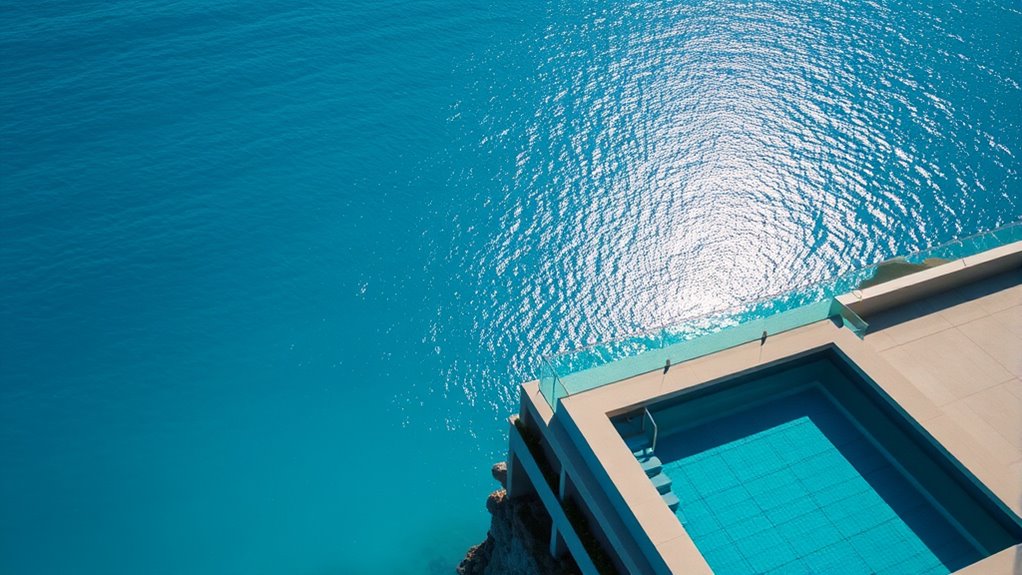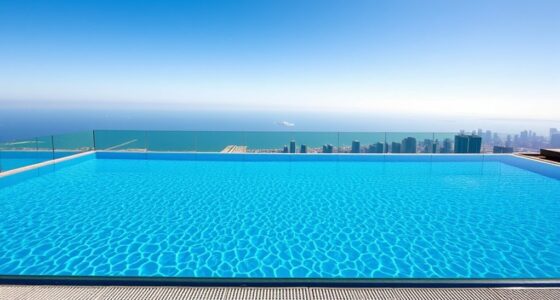An infinity pool typically costs $100,000 to $300,000 or more, markedly higher than standard in-ground pools, which range from $20,000 to $50,000. The main differences come from complex construction, premium materials, and special features like waterfalls or spillover edges. Maintenance and higher energy costs also add up over time. If you want to understand how these factors stack up and affect your budget, keep exploring the details below.
Key Takeaways
- Infinity pools typically cost $100,000 to $300,000+, while standard in-ground pools range from $20,000 to $50,000.
- Construction and installation for infinity pools are more complex, increasing initial costs significantly.
- Maintenance and operational expenses are higher for infinity pools due to advanced features and water requirements.
- Permitting and insurance premiums tend to be more expensive for infinity pools because of their size and complexity.
- Long-term costs favor standard pools, which generally require less upkeep and have a longer lifespan.
Initial Installation Costs

When comparing initial installation costs, infinity pools generally require a larger budget upfront than standard in-ground pools. This is because infinity pools involve more complex construction, such as specialized spillover edges and precise engineering to achieve the desired visual effect. You’ll need to factor in higher expenses for excavation, reinforced structures, and custom plumbing systems. Additionally, the materials used often cost more, especially if you opt for high-end finishes and durable liners. The overall process also takes longer, requiring skilled labor and meticulous craftsmanship. While the upfront investment is significant, these costs reflect the intricate design and unique aesthetic that infinity pools offer. Expect to pay a premium initially, but consider the stunning visual impact it creates, as well as the custom craftsmanship involved in their construction.
Material and Design Considerations

Material and design choices play a significant role in shaping both the aesthetics and functionality of your infinity or standard pool. Your selection impacts durability, maintenance, and visual appeal. For example:
- Surface Materials: Concrete, fiberglass, or vinyl liners each have different costs, longevity, and maintenance needs.
- Design Features: Elements like lighting, waterfalls, or ledges add beauty but can increase expenses.
- Color and Finish: Darker finishes may look sleek but can absorb more heat, affecting comfort and energy use.
4: Considering the use of energy-efficient systems and electricity production from bike generators can help offset operational costs over time.
Choosing high-quality, durable materials might cost more initially but can save you money long-term. Keep in mind that a well-designed pool aligns with your style while considering your budget and maintenance preferences.
Excavation and Site Preparation
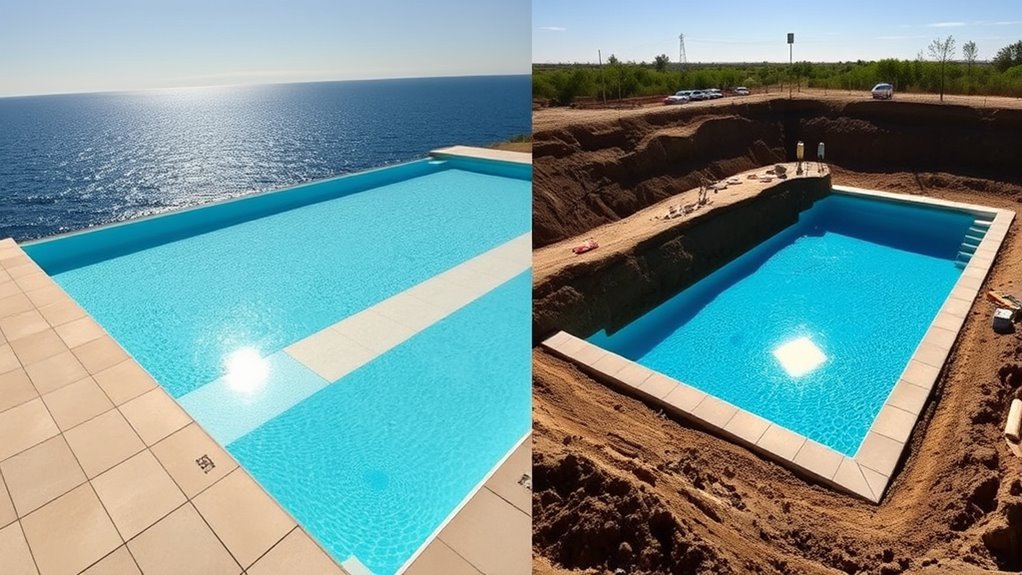
The costs for site excavation can vary widely depending on your property’s terrain and size. You’ll also need to budget for preparation materials like gravel, concrete, or drainage systems. Understanding these expenses helps you gauge the overall investment for your pool project. Additionally, incorporating custom aesthetic modifications can influence the total cost and design considerations.
Site Excavation Costs
Excavation and site preparation costs can substantially impact the overall budget of installing either an infinity pool or a standard in-ground pool. These costs depend on factors like soil condition, pool size, and accessibility. Typically, larger or more complex pools require more extensive excavation, increasing expenses.
Here are three key points to ponder:
- Soil Type: Hard clay or rocky terrain demands extra equipment and labor, raising costs.
- Pool Size: Larger pools need more excavation work, which directly increases expenses.
- Site Accessibility: Difficult-to-reach sites may require special machinery or additional labor, adding to the total cost.
Understanding these factors helps you better estimate your excavation budget for both pool types.
Preparation Material Expenses
Preparation material expenses for site excavation and preparation can vary considerably depending on the type of soil and the scope of work required. The costs include gravel, sand, and compacting materials essential for stable pool foundations. Here’s a rough breakdown:
| Material | Typical Cost | Purpose |
|---|---|---|
| Gravel | $30 – $50/ton | Foundation drainage |
| Sand | $25 – $45/ton | Leveling under pool structure |
| Geotextile Fabric | $0.50 – $2/sq ft | Soil stabilization |
| Rebar | $0.80 – $1.20/lb | Reinforcement for concrete |
| Waterproofing Membrane | $3 – $7/sq ft | Pool shell protection |
Your expenses depend on soil type, size, and project scope, influencing the amount of materials needed.
Plumbing and Electrical Requirements
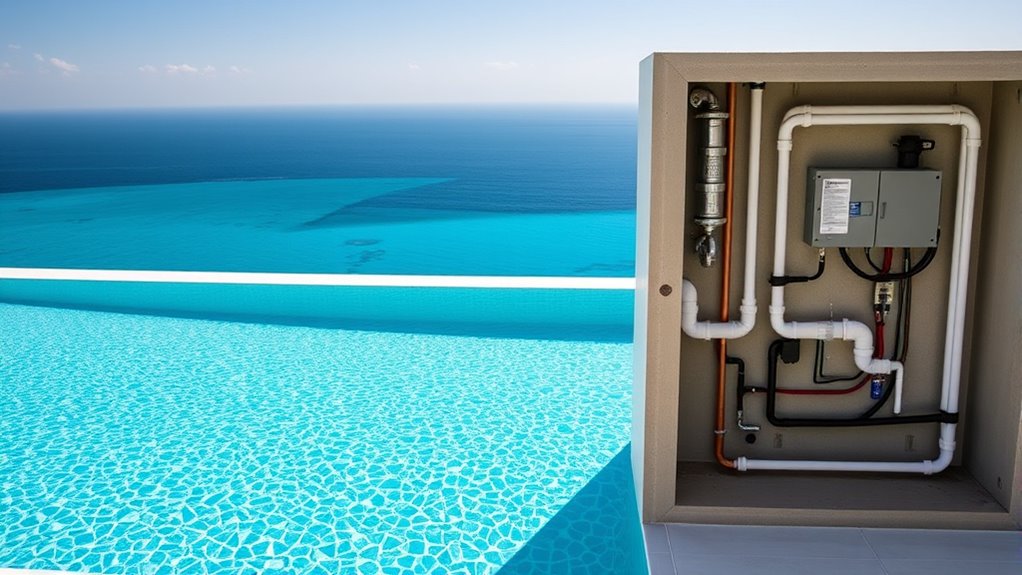
Since infinity pools often feature integrated lighting, waterfalls, or jets, they typically demand more complex plumbing and electrical setups than standard in-ground pools. You’ll need specialized systems to handle the additional equipment and guarantee proper water flow. This means increased installation costs and more extensive wiring. Additionally, high-quality color accuracy in lighting and features can enhance the overall aesthetic and ambiance of your pool area.
Cost of Pool Features and Upgrades

When considering pool features and upgrades, you’ll notice significant cost differences between basic construction and luxury additions. Upgrading for features like waterfalls, lighting, or automation can quickly increase your expenses. It’s important to weigh these costs against maintenance fees to make sure your pool remains both stunning and affordable. Additionally, understanding the personality traits of your preferences can help you choose features that align with your lifestyle and enhance your overall satisfaction.
Basic Pool Construction Costs
Basic pool construction costs primarily depend on the features and upgrades you choose, affecting both the initial investment and long-term expenses. Your choices influence the overall price and how much maintenance you’ll need later. Here are some key factors to deliberate:
- Pool Size and Shape: Larger or more complex designs increase materials and labor costs.
- Material Choices: Concrete, fiberglass, or vinyl liners each have different price points and durability.
- Additional Features: Items like steps, decking, or lighting add to the cost but enhance usability and aesthetics.
- Creative expression and artistic features can significantly impact the pool’s overall appeal and longevity, especially when considering artistic expression in design choices.
Focusing on these basics helps you estimate your initial budget. Keep in mind, opting for high-end features will boost costs, but they may also improve your pool’s longevity and appeal.
Luxury Feature Expenses
Adding luxury features to your pool can considerably increase its cost but also greatly enhance its overall appeal and functionality. Upgrades like waterfalls, built-in lighting, sundecks, or advanced heating systems can elevate your pool experience but come with higher price tags. Infinity pools, due to their complex design, often require custom features such as glass walls or spillover edges, which add to the expense. Standard in-ground pools may also include upscale options like decorative tile work or automated covers, but these tend to be more affordable than infinity-specific elements. Keep in mind that while these features boost aesthetics and usability, they can quickly inflate your budget. Carefully consider which luxury features align with your priorities to maximize value without overspending.
Upgrade and Maintenance Fees
Upgrading your pool with luxury features can particularly increase both initial costs and ongoing expenses. These upgrades often require higher maintenance and more frequent repairs, adding to your long-term costs. For instance:
- Advanced Lighting Systems – These enhance aesthetics but may need regular bulb replacements and electrical checks.
- Automated Cleaning Systems – While they reduce manual effort, they come with costly parts and servicing.
- Custom Water Features – Fountains or waterfalls boost visual appeal but increase water and energy consumption, raising utility bills.
- Specialized Maintenance Requirements – Infinity pools often demand more professional maintenance due to their complex design and water circulation systems.
Both infinity and standard pools incur maintenance fees, but infinity pools often demand more due to complex features and specialized upkeep. Budgeting for these ongoing costs ensures your investment remains enjoyable without surprises.
Maintenance and Operating Expenses
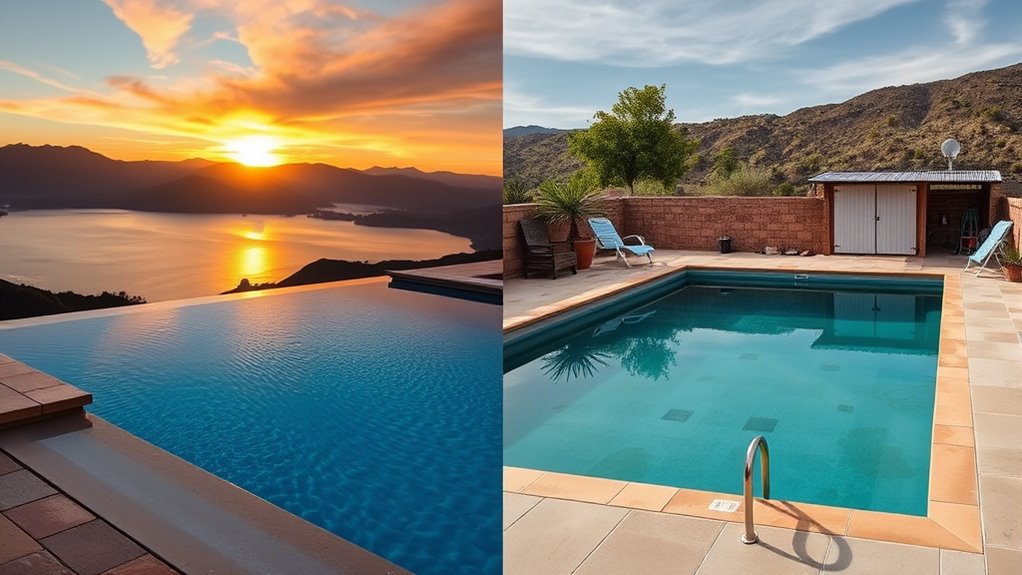
While infinity pools often provide a stunning visual appeal, they tend to require higher maintenance and operating expenses compared to standard in-ground pools. The unique design, with its continuous edge, demands specialized cleaning tools and frequent inspections to prevent water loss or structural issues. You’ll need to keep a close eye on the water level, as evaporation is more noticeable, increasing water and chemical costs. The pumps and filtration systems are often more powerful and complex, leading to higher energy bills. Additionally, the open-edge feature can make balancing chemicals more challenging, requiring more frequent adjustments. Overall, maintaining an infinity pool involves more time, effort, and ongoing expenses to keep it looking pristine and functioning smoothly. Moreover, the design complexity of infinity pools can lead to additional repair costs if issues arise with the structural or water management components.
Longevity and Resale Value
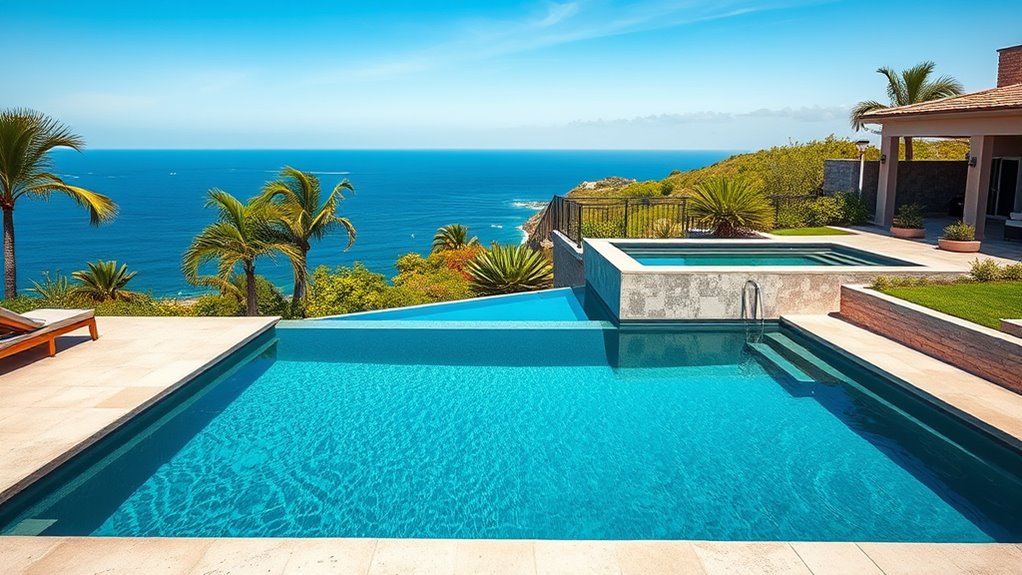
Infinity pools often boast a modern, luxurious look that can enhance a property’s overall appeal, but their longevity and resale value depend heavily on construction quality and maintenance. If built with high-quality materials and maintained properly, they can last 20-30 years or more. However, poor construction or neglect can lead to issues like leaks, cracks, or fading, reducing lifespan and resale value. To maximize your investment, consider these factors:
- Regular inspections and prompt repairs keep the pool in top condition.
- Using durable, weather-resistant materials extends lifespan.
- A well-maintained infinity edge and surrounding features boost curb appeal and resale potential.
- Maintenance practices play a crucial role in preserving the pool’s integrity and appearance over time.
Proper upkeep guarantees your infinity pool remains a valuable asset for years to come.
Insurance and Permitting Fees
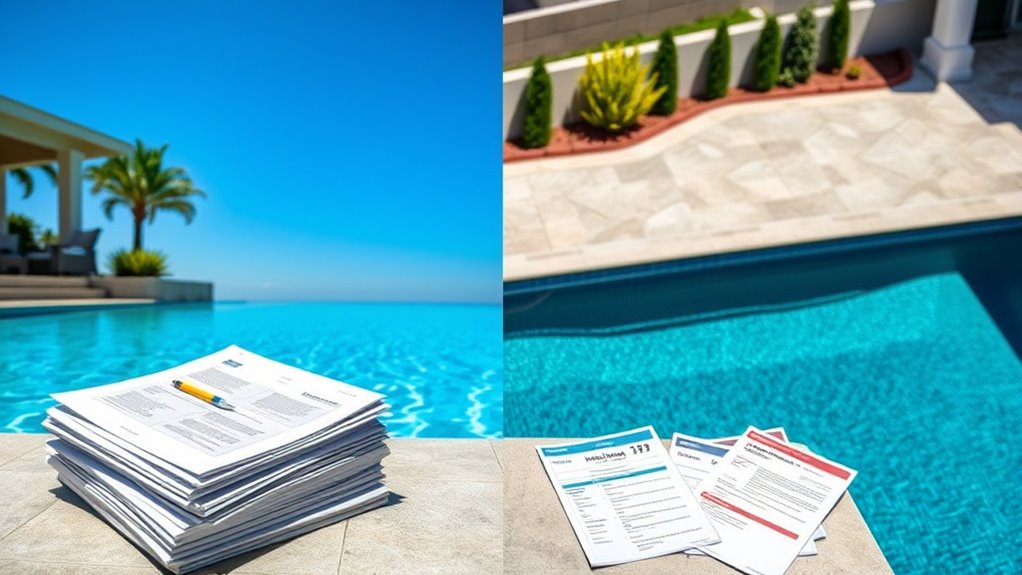
Insurance and permitting fees can considerably impact the overall cost of installing and maintaining your pool. Infinity pools often require special permits due to their unique design and structure, which can lead to higher application and inspection costs. Insurance premiums may also increase because infinity pools are considered higher risk, especially if they’re larger or have complex features. You might face additional liability coverage or safety requirements that add to your expenses. You may also want to consider how creative practice can help you approach planning and budgeting for these costs more effectively. Standard in-ground pools generally have more straightforward permitting processes and lower insurance premiums because they’re more common and perceived as less risky. To avoid surprises, you should consult your local authorities about specific permits and talk to your insurance provider to understand potential premium increases before proceeding.
Overall Cost-Benefit Analysis

When comparing the overall costs and benefits of infinity pools versus standard in-ground pools, it’s essential to look beyond initial expenses to understand long-term value. Consider these factors:
- Maintenance Costs: Infinity pools often require more maintenance due to their unique design, but they can add aesthetic appeal that boosts property value.
- Lifespan and Durability: Standard pools usually last longer with lower repair costs, offering better long-term savings.
- Resale Value: Infinity pools can increase your property’s appeal, but their high costs might not always translate into proportional resale gains.
Balancing these benefits and costs helps you determine which option aligns best with your lifestyle, budget, and future plans.
Frequently Asked Questions
How Do Maintenance Costs Differ Over the Lifespan of Each Pool Type?
You’ll find that infinity pools generally have higher maintenance costs over their lifespan due to their complex design, additional features, and higher water and energy usage. Standard in-ground pools are usually easier and cheaper to maintain, with fewer parts prone to wear and tear. You’ll spend more on cleaning, repairs, and equipment for infinity pools, while standard pools typically require less frequent upkeep and lower ongoing expenses.
Are There Significant Differences in Energy Consumption Between Infinity Pools and Standard Pools?
You’ll find that infinity pools typically consume more energy than standard pools because they require additional pumps and filtration systems to maintain the water flow over the edge. The continuous circulation and higher water volume increase energy use. In contrast, standard pools usually have simpler setups, making them more energy-efficient. So, if energy costs matter to you, a standard pool might be the more economical choice over time.
What Are the Environmental Impacts of Installing and Operating Each Pool Type?
Think of your pool as a tiny planet—its installation and operation shape your environmental footprint. Infinity pools, with their sleek design, often require more energy for pumps and lighting, creating a larger ecological ripple. Standard pools, while simpler, still impact water use and chemicals. By choosing energy-efficient equipment and sustainable materials, you can minimize harm, turning your backyard oasis into a symbol of harmony with nature.
How Do Insurance Premiums Vary Between Infinity Pools and Traditional In-Ground Pools?
You’ll likely pay higher insurance premiums for infinity pools because they’re considered more of a risk due to their design, such as the open edge and potential fall hazards. Traditional in-ground pools generally cost less to insure since they’re more enclosed and have fewer safety concerns. However, premiums depend on factors like pool size, safety features, and your location, so it’s best to get personalized quotes from your insurer.
Can Upgrades or Renovations Be More Cost-Effective for One Pool Type Over the Other?
Imagine upgrading your backyard with a sleek infinity pool that blends seamlessly into the landscape. Generally, renovations tend to be more cost-effective for standard in-ground pools because they usually involve simpler repairs and updates. Infinity pools often require specialized equipment and custom features, making upgrades pricier. If budget is a concern, sticking with a traditional in-ground pool might save you money while still enhancing your outdoor space.
Conclusion
When comparing infinity pools to standard in-ground pools, remember that infinity pools can cost up to 50% more upfront. However, their stunning design often boosts property value by an average of 7%. If you’re seeking a luxurious look and unique aesthetic, the investment might be worth it. Consider your budget and long-term goals carefully—after all, a well-maintained infinity pool can be a striking centerpiece that enhances your home’s appeal for years to come.
